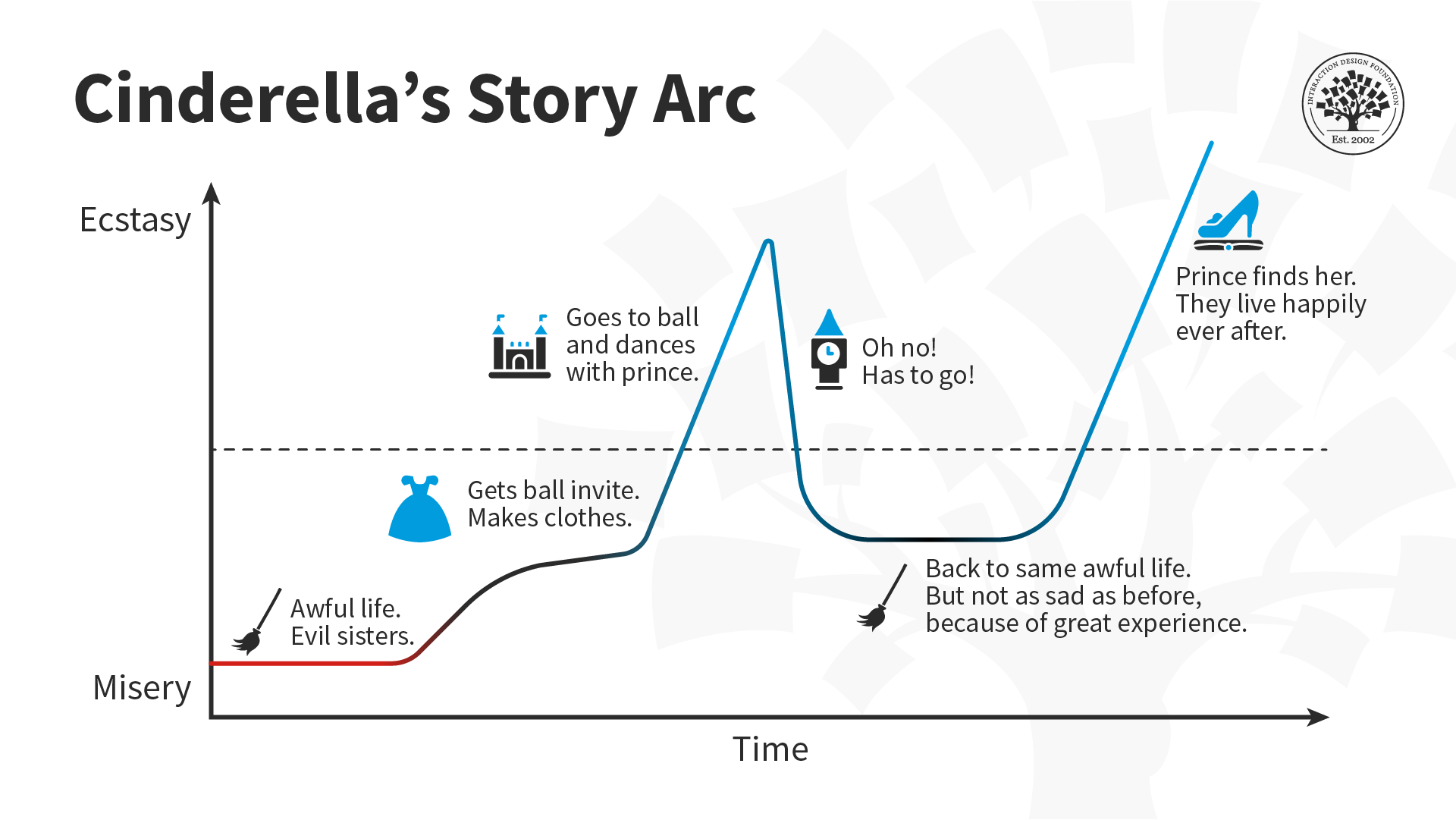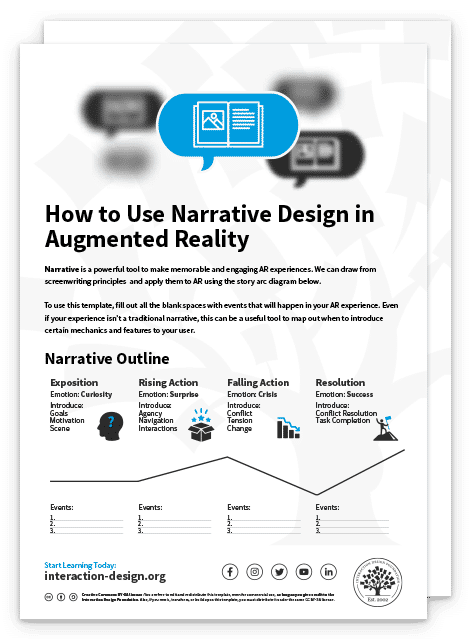Augmented Reality (AR) is particularly effective for place-based stories. Because of how human memory works, place-based narratives are powerful tools for education and entertainment. UX designers for AR look for opportunities to turn seemingly uninteresting spaces into engaging stories or tedious tasks into playful and memorable narratives.
Show
Hide
video transcript
- Transcript loading…
Video copyright info
Copyright holder: MetaHub Appearance time: 3:12 - 3:22 Copyright license and terms: CC BY Link: https://www.youtube.com/watch?v=pLMP8zcIF38&ab_channel=MetaHub
What Makes AR Memorable?
Augmented reality's earliest uses were in entertainment, and the medium's strength remains in place-based storytelling. In a way, augmented reality is an evolution of open-air theater and public art, which turn public spaces into stages or exhibitions. As a designer, you should consider narrative an essential element of your design. Part of why storytelling in AR is so compelling is that it is immersive and memorable.
This is due to two main phenomena related to the science of memory, or mnemonics.
We remember stories better than facts. Teachers have used the "mnemonic linking method" or "chain method" for generations to teach the planets, geography and other difficult-to-remember facts. One example of this is the English mnemonic device to remember the colors of the rainbow:
"Richard Of York Gave Battle In Vain."
It helps us remember the following:
"Red, Orange, Yellow, Green, Blue, Indigo, Violet."
Countless phrases like this in many languages and cultures reflect our shared interest in narrative throughout history.
Humans associate memories with physical space: This phenomenon is called the "method of loci" and describes how memories link to familiar places. You can feel this effect whenever you enter a room and forget why you entered it in the first place. The ancient Greeks used this method to develop "memory palaces," imaginary spaces to store memories. This is particularly relevant in UX for AR, where digital content exists in physical space.
In this example, AR artist John Craig Freeman turns a simple fact into a memorable story experience.
The augmented reality art installation "Windsor Mill" by John Craig Freeman.
© John Craig Freeman, Fair Use
Tips for Narrative Design in AR
With AR experiences, consider the environment a story space or stage, and think of your user journey as a narrative. Where does the user experience begin and end? How can you introduce conflict, and how will you resolve it? Why does this interaction happen in this place in particular?
Provide cues, spark emotions and guide discovery to evoke an emotional response from your users. User research methods like journey maps and personas will help visualize that journey. Storyboards, improv and bodystorming exercises can also help make a compelling story and visualize what it will look like in real space. Designers will have to think like screenwriters and craft a narrative structure that is satisfying and engages users. The success of the narrative also depends on how it works in the physical space and the hardware and software the design will be experienced with. That’s why spatial cognition and field of view (FOV) is especially important in Extended Reality (XR).
Screenwriters often employ a narrative structure like the one below. Here's an example of what the story arc for Cinderella looks like.

A graphical representation of the story of Cinderella, originally based on a doodle by author Kurt Vonnegut.
© Interaction Design Foundation, CC BY-SA 4.0
For interactive mediums like AR, we can map specific tasks to areas in the narrative. For example, the exposition stage introduces both the setting and characters and the mechanics of the experience, like how to move and interact with the environment.

This adapted narrative graph for AR experiences includes the intended emotional state for each stage.
© Interaction Design Foundation, CC BY-SA 4.0
Download our Narrative Outline Template to Get Started Now
Narratives can be a powerful tool to map out the stages of an interactive story. Learn how you can use narrative to improve your user experience in our template:


When you storyboard or write a script for your narrative, create a modified user journey map like the one above. Each stage should elicit certain emotions; specific tasks belong in each emotional stage.
Curiosity / Exposition: In this stage, introduce goals to the user, and motivate them to continue exploring. Establish the world the story takes place in.
Surprise / Rising Action: Next, open up the experience and introduce the functions available to the user. Let them know how they can move around and interact with the narrative. This includes movement, navigation, and input. Introduce the conflict the user has to solve.
Crisis / Climax: Introduce an obstacle to the user's goals. Have the user address the conflict and try to resolve it. Change the environment in a way that causes tension.
Success / Falling Action and Resolution: Allow users to resolve conflicts, complete tasks, and enjoy rewards.
The user has agency in the narrative, so the story should react to their actions and draw them deeper into the experience. Use real spaces as stages, and the experience will stick with your user long after they close the app.
The Take Away
To make an AR experience meaningful, it must also be memorable. Narratives are an excellent way to increase immersion and user engagement. Storytelling should be considered a design tool to create more memorable experiences.
AR is particularly suited for memorable experiences because human brains naturally tie memories to physical space and retain stories better than abstract facts. To craft AR narratives, think about narrative cues that guide discovery, and be deliberate about the emotions you evoke at each stage of the user's journey.
References and Where to Learn More
Watch our Master Class on The Power of Storytelling in UX.
Watch journalist and US memory champion Josh Foer's Ted talk, Feats of memory anyone can do.
For more on Josh Foer's Article on Mnemonic methods, read Forget Me Not: How to Win the U.S. Memory Championship.
Watch a virtual roundtable on how AR is a new form of public art in Public Art in the Digital Age: A Curated Conversation on Augmented Reality.
See how ancient Greeks used Mnemonics in Method of Loci: Ancient Mnemonic Technique Used by Greeks and Romans Effectively Double Brain's Memory Storage Skills.
Read John Butcher's book on storytelling in VR and AR Storytelling for Virtual Reality: Methods and Principles for Crafting Immersive Narratives.
For more on how screenwriters think about stories, read The Pixar Storytelling Formula: What You Need To Know.
Hero Image: ©John Craig Freeman, Fair Use











